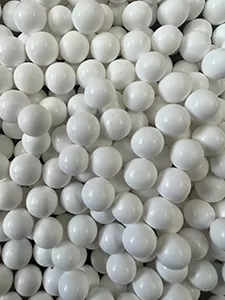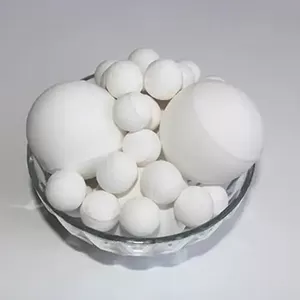Ceramic balls used in ball mills are generally non - toxic under normal conditions, as they are primarily made of inert materials like alumina, zirconia, or silicon carbide, but potential toxicity may arise from wear debris or specific additives in certain cases. Their safety depends on material composition, usage scenarios, and exposure pathways, which are critical considerations for industrial and environmental safety.

Most ceramic balls, such as those made of high - purity alumina (Al₂O₃), are chemically inert and non - toxic. Alumina is a stable compound that does not react with most substances under normal grinding conditions, making it safe for applications involving food, pharmaceuticals, or cosmetics. Similarly, zirconia (ZrO₂) ceramic balls, often stabilized with yttria, are biocompatible and non - toxic, which is why they are used in medical devices and food processing equipment.
Silicon carbide (SiC) ceramic balls, another common type, are also non - toxic in their solid form. Their inert nature allows them to be used in grinding processes for chemicals and minerals without leaching harmful substances. These materials resist corrosion and do not release toxic fumes or particles under standard operating temperatures in ball mills.
However, potential risks emerge when ceramic balls wear down, producing fine debris or dust. Inhalation of these small particles, regardless of the material, can pose respiratory risks, similar to other fine industrial dusts. While the ceramic materials themselves are not toxic, prolonged exposure to high concentrations of wear debris may irritate the lungs or cause long - term respiratory issues, especially in poorly ventilated workspaces.

Certain ceramic balls with specific additives may present additional concerns. For example, some low - cost ceramic balls might contain trace amounts of heavy metals as sintering aids or impurities. If these metals leach into grinding materials—particularly in processes involving acidic or alkaline substances—they could contaminate the final product, introducing toxicity risks. This is rare in high - quality industrial ceramic balls, which undergo strict purity controls.
In applications where the ground material comes into contact with food or pharmaceuticals, regulatory standards often require ceramic balls to meet safety certifications. These certifications ensure that the balls are free from harmful additives and that their wear debris does not compromise product safety. For instance, ceramic balls used in pharmaceutical grinding must comply with guidelines that restrict leachable substances to negligible levels.
Proper handling and maintenance further mitigate potential risks. Regular inspection of ceramic balls to replace worn ones reduces the generation of excessive debris. Implementing effective dust collection systems in ball mill operations minimizes inhalation exposure, protecting workers from respiratory hazards associated with ceramic dust, even if the dust itself is non - toxic.
In summary, ball mill ceramic balls are typically non - toxic due to their inert compositions, but caution is necessary regarding wear debris inhalation and potential trace additives. Adhering to quality standards, maintaining equipment, and ensuring proper ventilation are key to ensuring their safe use in industrial processes.



